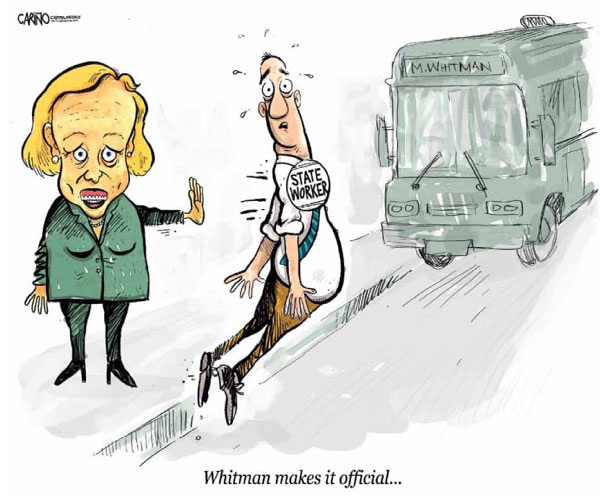OAK GLEN - A quick look at Pomona native Adam Salas reveals a quirky smile peering out from under a helmet as he and the rest of a firefighting crew inspect their chainsaws at the Oak Glen Conservation Camp.But a second glance stumbles upon the words "CDCR Prisoner" stamped on his orange uniform and gang insignia tattooed on his eyelids, hands and neck.
Salas, 23, had never been outside Pomona until he made a terrorist threat during an argument about two years ago. That threat landed him in Tehachapi State Prison, and later Oak Glen. From there, he was dispatched to fight fires in Santa Barbara, Madera and Mariposa counties.
Low-risk offenders like Salas comprise the majority of the manpower for CalFire, the state's firefighting agency. But efforts to reduce the state prison population may redirect them to alternate custody, such as home confinement.
Some people worry that the void on the fire lines will be filled with more dangerous inmates classified as Level 3 offenders.
"We are concerned about the safety," said Mike Hampton, vice president of California Correctional Peace Officers Association's fire camp chapter. "We don't have staff to handle Level 3."
Officially, the proposal to speed up transfers of Level 3 inmates is "not at the table at this time," said Ray Harrington, correctional administrator with CDCR.
No alternatives have been proposed at this time either, Harrington said.
"We can't use them (low-risk offenders) as pawns to save state money," he said.
In conjunction with the California Department of Corrections and Rehabilitation, CalFire operates 39 conservation camps, which house more than 4,000 prisoners.
Each year, inmate crews put in more than 2.5 million hours responding to emergencies such as wildfires, floods or earthquakes, according to CalFire.
When there are no fires burning, crews conduct labor-intensive projects on public lands, such as repair and maintenance of levies for flood prevention, maintenance of state and federal parks, clearing debris from streams or removing roadside litter.
Participating prisoners are screened through a "stringent classification process" that determines their suitability for the fire camp program, said Sgt. John Lanthripp of Oak Glen.
Sex offenders, arsonists and inmates with a history of escapes are automatically disqualified.
The screening process starts as soon as inmates arrive at a state prison. They are assigned a certain number of points, based on their offense or their criminal history.
Inmates charged with nonviolent offenses - such as DUI, burglary, car theft, receiving stolen property and various drug charges - are usually classified as Level 1 or 2 and are most commonly picked to serve their sentence at a fire camp.
An array of robbery and burglary offenses fit into Level 3 category, including carjacking and armed robbery. According to a UCLA study, all offenders sentenced to life without parole are automatically assigned level 3.
Level 4 prisoners, such as murderers, are assigned the most points. If they stay out of trouble during the incarceration, their points can be reduced and their security level eventually downgraded.
When Mark Planavsky of Newport Beach entered Folsom State Prison 16 years ago he was classified as the worst of the worst - Level 4.
Although his offense was a string of nonviolent residential burglaries, Planavsky already had two strikes on his record and was facing a life sentence. That gave prison authorities a reason to dole out as many points as they could.
"I was serving time with lifers, people who have nothing to look forward to," he said.
Ten years later, his impeccable behavior has earned him a transfer to Oak Glen fire camp as a Level 1 offender.
"Here you have freedom, there are no lockdowns," Planavsky said. "You can turn a doorknob on your own."
Because of success cases such as Planavsky's, CDCR is considering speeding up the process of bringing Level 3 inmates to the fire camps - a proposal made during a meeting with CDCR administration, Hampton said.
CDCR plans to "do a Level 3 override" and transfer Level 3 offenders to fire camps without waiting for their points to drop - a gamble in which public safety can be impacted, he said.
Hampton works as a correctional officer at Delta Fire Camp in Solano County. He remembers a "camper" who was involved in a shoot-out with Los Angeles police. The inmate was not classified as violent because he did not strike the officers.
"He was a bad shooter, so he can go to camp," Hampton said.
Incidence of riots or escapes may increase if fire camps house riskier inmates, Hampton said.
"To be in a camp you have to meet certain criteria, like have less than five years to serve," Hampton said. "They will change that and those who have 10 to do will be eligible to come. Officers have pepper spray only, (so) if a riot happens, what then?"
At Oak Glen, a staff of 16 take turns watching over 165 inmates.
"There can be no less than two officers in charge at any time," Lanthripp said. "That's usually at night."
In July 2008, two inmates walked away from Oak Glen. One was captured within 20 minutes of escaping while the other broke into the house of a sheriff's deputy and was later captured at his girlfriend's house in Rancho Cucamonga.
"It's very easy to escape," inmate Milton White said. "But then you'll get caught and do some more time."
White's attitude is widespread among inmates at Oak Glen, Lanthripp said.
Should demographics change at his fire camp, he is confident it will be done responsibly.
"I have to trust the classification process," he said.
Either way, Lanthripp said he hopes the fire camp program is preserved, as it benefits both the state and the inmates.
Amidst tall pine trees and beautiful vistas at the conservation camp, Salas, the slender young man, is paying back his dues to society.
"I break my back for this job and it feels good," Salas said. "When I'm done, I look back and it looks a lot better than when I came in."
Tuesday, December 8, 2009
Riskier inmates may serve in fire camps
Subscribe to:
Post Comments (Atom)
Blog Archive
-
▼
2009
(50)
-
▼
December
(9)
- OC Register editorial gives kudos to own reporters...
- MY FINAL THOUGHTS ON THE MEMBERS4CHANGE
- OIG says inmate lawsuits cost Calif. (much more th...
- Another Chapter in our lives
- COLLEGE KIDS AND "OLD SCHOOL" OFFICERS
- Riskier inmates may serve in fire camps
- David R Lopez December 7 at 5:38pm Monday, Decembe...
- Editorial: Paycheck protection is back
- PROBLEMS WITH JESICA LAW
-
▼
December
(9)
































No comments:
Post a Comment